电子科技大学:《语言学通论 General Linguistics》课程教学资源(课件讲稿)05 句法 Syntax
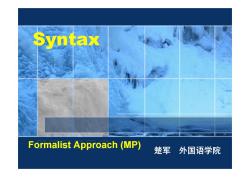
Syntax Formalist Approach(MP) 楚军外国语学院
Formalist Approach (MP) 楚军 外国语学院 Syntax

MP-model Introduction Why Minimalism? The overall aim of MP continues the tradition of making statements about human languages that are as simple and general as possible. From the early 1960s,the central objective of TG grammar was to abstract general principles from the complex rule systems devised for particular languages, leaving rules that are simple,constrained in their operation by the UG principles. The minimalist framework continues this drive for simplification
MP-model : Introduction Why Minimalism? The overall aim of MP continues the tradition of making statements about human languages that are as simple and general as possible. From the early 1960s, the central objective of TG grammar was to abstract general principles from the complex rule systems devised for particular languages, leaving rules that are simple, constrained in their operation by the UG principles. The minimalist framework continues this drive for simplification
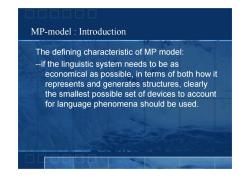
MP-model Introduction The defining characteristic of MP model: --if the linguistic system needs to be as economical as possible,in terms of both how it represents and generates structures,clearly the smallest possible set of devices to account for language phenomena should be used
MP-model : Introduction The defining characteristic of MP model: --if the linguistic system needs to be as economical as possible, in terms of both how it represents and generates structures, clearly the smallest possible set of devices to account for language phenomena should be used
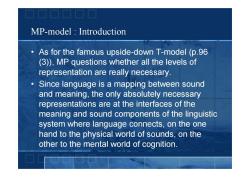
MP-model Introduction As for the famous upside-down T-model (p.96 (③),MP questions whether all the levels of representation are really necessary. ● Since language is a mapping between sound and meaning,the only absolutely necessary representations are at the interfaces of the meaning and sound components of the linguistic system where language connects,on the one hand to the physical world of sounds,on the other to the mental world of cognition
MP-model : Introduction • As for the famous upside-down T-model (p.96 (3)), MP questions whether all the levels of representation are really necessary. • Since language is a mapping between sound and meaning, the only absolutely necessary representations are at the interfaces of the meaning and sound components of the linguistic system where language connects, on the one hand to the physical world of sounds, on the other to the mental world of cognition
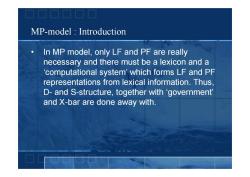
MP-model Introduction In MP model,only LF and PF are really necessary and there must be a lexicon and a computational system'which forms LF and PF representations from lexical information.Thus, D-and S-structure,together with 'government' and X-bar are done away with
MP-model : Introduction • In MP model, only LF and PF are really necessary and there must be a lexicon and a ‘computational system’ which forms LF and PF representations from lexical information. Thus, D- and S-structure, together with ‘government’ and X-bar are done away with
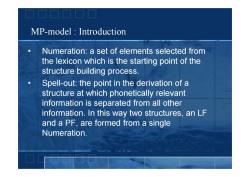
MP-model Introduction Numeration:a set of elements selected from the lexicon which is the starting point of the structure building process. Spell-out:the point in the derivation of a structure at which phonetically relevant information is separated from all other information.In this way two structures,an LF and a PF,are formed from a single Numeration
MP-model : Introduction • Numeration: a set of elements selected from the lexicon which is the starting point of the structure building process. • Spell-out: the point in the derivation of a structure at which phonetically relevant information is separated from all other information. In this way two structures, an LF and a PF, are formed from a single Numeration
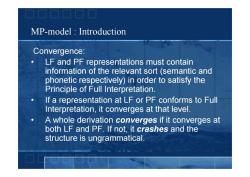
MP-model Introduction Convergence: LF and PF representations must contain information of the relevant sort (semantic and phonetic respectively)in order to satisfy the Principle of Full Interpretation. If a representation at LF or PF conforms to Full Interpretation,it converges at that level. A whole derivation converges if it converges at both LF and PF.If not,it crashes and the structure is ungrammatical
MP-model : Introduction Convergence: • LF and PF representations must contain information of the relevant sort (semantic and phonetic respectively) in order to satisfy the Principle of Full Interpretation. • If a representation at LF or PF conforms to Full Interpretation, it converges at that level. • A whole derivation converges if it converges at both LF and PF. If not, it crashes and the structure is ungrammatical

MP-model Introduction Structure Building: Merge:the combinatorial process which forms structures from elements in the Numeration and other partially built structures. Move:the movement process which also plays a role in structure building-e.g.a specifier position will be created as part of the process of moving an element into it
MP-model : Introduction Structure Building: Merge: the combinatorial process which forms structures from elements in the Numeration and other partially built structures. Move: the movement process which also plays a role in structure building—e.g. a specifier position will be created as part of the process of moving an element into it
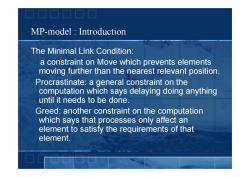
MP-model Introduction The Minimal Link Condition: a constraint on Move which prevents elements moving further than the nearest relevant position. Procrastinate:a general constraint on the computation which says delaying doing anything until it needs to be done. Greed:another constraint on the computation which says that processes only affect an element to satisfy the requirements of that element
MP-model : Introduction The Minimal Link Condition: a constraint on Move which prevents elements moving further than the nearest relevant position. Procrastinate: a general constraint on the computation which says delaying doing anything until it needs to be done. Greed: another constraint on the computation which says that processes only affect an element to satisfy the requirements of that element
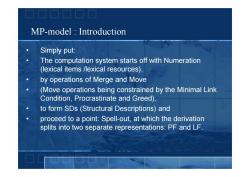
MP-model Introduction Simply put: The computation system starts off with Numeration (lexical items /lexical resources), by operations of Merge and Move ● (Move operations being constrained by the Minimal Link Condition,Procrastinate and Greed), to form SDs(Structural Descriptions)and proceed to a point:Spell-out,at which the derivation splits into two separate representations:PF and LF
MP-model : Introduction • Simply put: • The computation system starts off with Numeration (lexical items /lexical resources), • by operations of Merge and Move • (Move operations being constrained by the Minimal Link Condition, Procrastinate and Greed), • to form SDs (Structural Descriptions) and • proceed to a point: Spell-out, at which the derivation splits into two separate representations: PF and LF
按次数下载不扣除下载券;
注册用户24小时内重复下载只扣除一次;
顺序:VIP每日次数-->可用次数-->下载券;
- 电子科技大学:《语言学通论 General Linguistics》课程教学资源(课件讲稿)04 Formalist Approach.pdf
- 电子科技大学:《语言学通论 General Linguistics》课程教学资源(课件讲稿)03 Formalist Approach.pdf
- 电子科技大学:《语言学通论 General Linguistics》课程教学资源(课件讲稿)02 句法 Syntax.pdf
- 电子科技大学:《语言学通论 General Linguistics》课程教学资源(课件讲稿)01 Introduction(主讲:楚军).pdf
- 山东省“成人教育特色课程”项目配套教材:《大学语文》课程教材电子版(主编:戴永新).pdf
- 聊城大学:《大学语文》课程教学资源(阅读文献)中国现当代文学经典作品选.pdf
- 聊城大学:《大学语文》课程教学资源(阅读文献)外国文学经典作品选.pdf
- 聊城大学:《大学语文》课程教学资源(阅读文献)中国古代文学经典作品选.pdf
- 聊城大学:《大学语文》课程教学资源(电子教案讲义,共十五讲).docx
- 运城学院:《文学概论 literature theory》课程教学资源(电子教案,打印版,2/2,共两编八章).pdf
- 运城学院:《文学概论 literature theory》课程教学资源(电子教案,打印版,1/2,共三篇八章).pdf
- 运城学院:《文学概论 literature theory》课程教学资源(教学大纲,打印版).pdf
- 运城学院:《秘书写作 Daily practical Writing》课程PPT教学课件(事务文书写作)15.总结述职报告.ppt
- 运城学院:《秘书写作 Daily practical Writing》课程PPT教学课件(事务文书写作)14.讣告悼词.ppt
- 运城学院:《秘书写作 Daily practical Writing》课程PPT教学课件(事务文书写作)13.欢迎欢送答谢表扬邀请信.ppt
- 运城学院:《秘书写作 Daily practical Writing》课程PPT教学课件(事务文书写作)12.聘书.ppt
- 运城学院:《秘书写作 Daily practical Writing》课程PPT教学课件(事务文书写作)11.请柬.ppt
- 运城学院:《秘书写作 Daily practical Writing》课程PPT教学课件(事务文书写作)10.求职信简历.ppt
- 运城学院:《秘书写作 Daily practical Writing》课程PPT教学课件(事务文书写作)09.倡议书建议书.ppt
- 运城学院:《秘书写作 Daily practical Writing》课程PPT教学课件(事务文书写作)08.启事.ppt
- 电子科技大学:《语言学通论 General Linguistics》课程教学资源(课件讲稿)06 Functional Grammar.pdf
- 电子科技大学:《语言学通论 General Linguistics》课程教学资源(课件讲稿)07 Semantics(Introduction).pdf
- 电子科技大学:《语言学通论 General Linguistics》课程教学资源(课件讲稿)语义学——Types of word-meaning.pdf
- 电子科技大学:《语言学通论 General Linguistics》课程教学资源(课件讲稿)语义学——Semantics(Sense Relations).pdf
- 电子科技大学:《语言学通论 General Linguistics》课程教学资源(课件讲稿)语义学——Context, changes in word meaning, figures of speech.pdf
- 电子科技大学:《语言学通论 General Linguistics》课程教学资源(课件讲稿)语义学——Componential Analysis.pdf
- 电子科技大学:《语言学通论 General Linguistics》课程教学资源(课件讲稿)语义学——Sentence meaning(Predication Analysis).pdf
- 电子科技大学:《语言学通论 General Linguistics》课程教学资源(课件讲稿)10 Langugae, culture & society.pdf
- 电子科技大学:《语言学通论 General Linguistics》课程教学资源(课件讲稿)09 Pragmatics(Utterance Meaning).pdf
- 电子科技大学:《语言学通论 General Linguistics》课程教学资源(课件讲稿)形态学 Morphology.pdf
- 电子科技大学:《语言学通论 General Linguistics》课程教学资源(课件讲稿)认知语言学中的相关话题 Cognitive Linguistics.pdf
- 弟子规(全文).pdf
- 《中国语言文化 Chinese Language and Culture》课程教学资源(书籍阅读材料)《中国古典哲学名著选读》郭齐勇.pdf
- 《中国语言文化 Chinese Language and Culture》课程教学资源(书籍阅读材料)《唐诗三百首》中英文对照(许渊冲)300 Tang Poems(Classified by Theme).pdf
- 《中国语言文化 Chinese Language and Culture》课程教学资源(书籍阅读材料)《二十四诗品校注译评》祖保泉.pdf
- 《中国语言文化 Chinese Language and Culture》课程教学资源(书籍阅读材料)《近代中国之种族观念》刘东.pdf
- 《中国语言文化 Chinese Language and Culture》课程教学资源(书籍阅读材料)《中国现代女作家与中国革命1905-1948》颜海平.pdf
- 《中国语言文化 Chinese Language and Culture》课程教学资源(书籍阅读材料)《世界秩序与文明等级》全球史研究的新路径(主编:刘禾).pdf
- 《中国语言文化 Chinese Language and Culture》课程教学资源(书籍阅读材料)《叫魂》SOULSTEALERS - The Chinese Sorcery Scare of 1768〔美〕孔飞力(1768年中国妖术大恐慌).pdf
- 电子科技大学:《中国语言文化 Chinese Language and Culture》课程教学资源(课件讲稿)导论(聂韬).pdf
